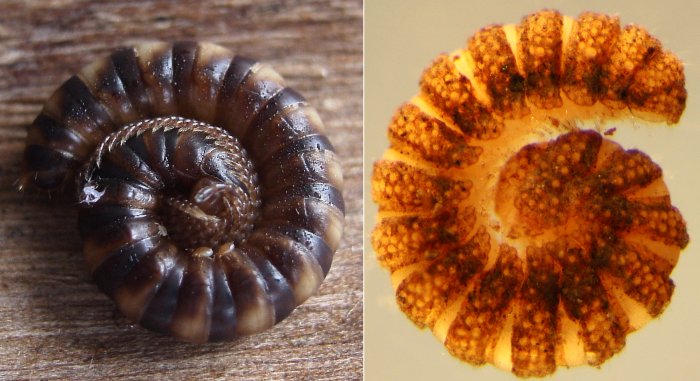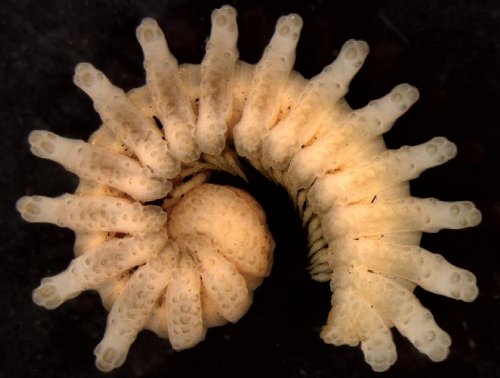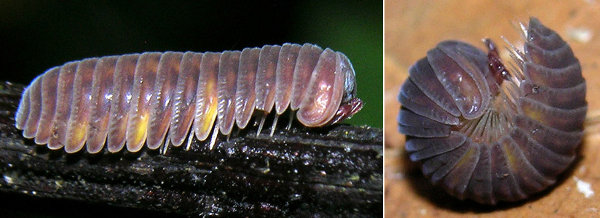Back to: mating
Forward to: glossary
Coiling
Most Polydesmida coil their bodies with the head towards the centre of a flat spiral:

(Left) Somethus tasmani (Paradoxosomatidae), Tasmania.
This species has greatly reduced paranota, and its long legs are exposed when it coils.
(Right) Asphalidesmus dorrigensis (suborder Dalodesmidea), New South Wales, Australia.
In this very small species the paranota are low on the body and bent downwards, protecting the short legs.
Coiling is a defence against predators. Fast coiling is usually accompanied by defecation, which may also be defensive. The fact that Polydesmida can be found resting in the coiled position in soil and leaf litter suggests that coiling may also protect polydesmidans against drying out.
If a polydesmidan has dorsal outgrowths, these radiate from the body coil and probably make the animal less easily eaten by large predators:

Eutrichodesmus aster (Haplodesmidae), Vietnam
Image courtesy S.I. Golovatch
Some Polydesmida are built so that they can coil into a 'ball' or 'pill' (see image below), like pill millipedes in the orders Glomerida and Sphaerotheriida. This kind of coiling, called volvation, has recently been studied by Sergei Golovatch (2003). He found that true volvation occurs in at least eight polydesmidan families.

Unidentified species of Oniscodesmidae, Barro Colorado Island, Panama
Family identification from these images by Julian Bueno-Villegas
Images © 2007 by Arthur Anker; used with permission
Coiling can be a nuisance for those of us who study Polydesmida, because many of the characters that need to be examined (such as the gonopods) are on the hidden, ventral side of the coiled animal. Polydesmida preserved in alcohol are usually quite rigid, and you may have to break a preserved, coiled specimen into pieces to see all its anatomical features.
An alternative is to remove the specimen from alcohol and soak it for a day or two in white (distilled) vinegar, which is 4-7% acetic acid in water. The weak acid dissolves calcium salts in the millipede's exoskeleton and makes the specimen flexible. Wash the specimen free of acetic acid by soaking it in several changes of clean water (say, a half hour for each change), then put it back into preservative. In my experience, vinegar treatment has no effect on the colours seen in preserved specimens.
Golovatch, S.I. 2003. A review of the volvatory Polydesmida, with special reference to the patterns of volvation (Diplopoda). African Invertebrates 44(1): 39-60.
Back to: mating
Forward to: glossary
